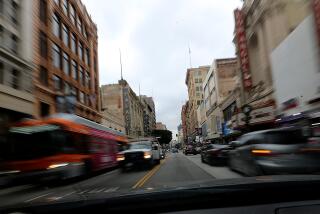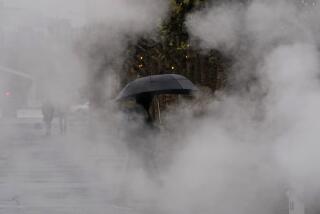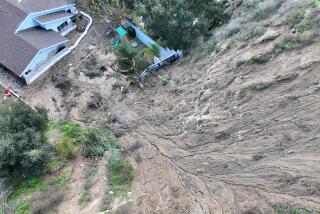New Orleans levee-risk study faulted
- Share via
When the Army Corps of Engineers admitted in June that design flaws in the New Orleans levee system had caused most of the flooding during Hurricane Katrina, it seemingly left little to argue about.
But the fight wasn’t over. The Corps is now engaged in an effort to predict how New Orleans would fare in the next big hurricane, and is once again being second-guessed by some of the nation’s top civil engineers.
The National Research Council complains that the Corps’ official investigation into the levee failures reaches premature conclusions, glosses over problems, and fails in its most important task: giving the public the information it needs to make informed decisions about living in New Orleans.
The Corps’ analysis will play a major role in determining the city’s future -- including whether more than 200,000 former residents could rebuild abandoned neighborhoods and whether insurers can provide coverage at an affordable rate.
The stakes are high, not only for the integrity of the levees around New Orleans but for similar levees that protect millions of Americans who live along vulnerable coastlines and rivers across the nation. Many were built on the same mucky foundations and with the same flawed engineering assumptions as the notorious failed 17th Street levee in New Orleans.
The suspect levees stretch from Florida’s Lake Okeechobee to the rivers of California’s Central Valley and the Sacramento-San Joaquin Delta, which has 2,300 miles of levees that protect cities and farmland.
The Corps’ investigation is essential to understanding California’s situation, said Les Harter, the levee chief at the California Department of Water Resources.
“The floodwalls in New Orleans were 15 years old, and they failed,” Harter said. “Our levees are 100 years old. We estimate we have one-half the level of protection that New Orleans had.”
The Corps is about six months behind schedule in issuing an all-important “risk analysis,” a massive body of work that is intended to tell the public how likely New Orleans is to flood again from a big hurricane.
The analysis is supposed to explain in precise detail how well specific sections of the city are protected against hurricanes, using evidence that hurricanes have intensified in recent years. The analysis would produce detailed maps.
Though the risk analysis has not been completed, the Corps did lay out the methodology it planned to use. Since then, the Corps’ work has been scrutinized by two key groups, the National Research Council and the American Society of Civil Engineers.
Its methodology has prompted much of the criticism, along with the Corps’ failure to say how confident it is in its assessment or to put the future risk in a historical context that New Orleans residents can understand, according to Richard Luettich, a member of the NRC review team and a professor at the University of North Carolina.
The research council, a quasi-federal organization that brings together the nation’s top experts on various public policy issues, urged the Corps in an October report to incorporate the views of other federal agencies with expertise in hurricane assessment and flood protection, something it had failed to do.
The Corps says it has since done so.
Some of the criticism is “misleading,” said Ed Link, a University of Maryland professor who is leading the Corps’ investigation.
Link, who spent much of his career in the Corps, acknowledged that the risk analysis is well behind schedule and said his team had underestimated the difficulty. But he said the Corps always intended to give the public the information that the NRC says is missing.
Originally, the Corps planned to run 2,000 hurricane scenarios through supercomputers, using a simplified mathematical model to predict how those storms would affect New Orleans. The NRC told the Corps it should use a more sophisticated model that had been developed to analyze Hurricane Katrina.
The sophisticated model, applied to 2,000 possible hurricanes, would have taken too long. So the Corps has reduced the number of hurricane scenarios to 150 and hopes to complete that work by February.
“I think we are going to get better results,” Link said.
Wayne Clough, chairman of the NRC review panel and president of the Georgia Institute of Technology, said he is waiting to see if the Corps will satisfy his panel’s concerns.
“It is challenging for them,” Clough said. “They have good people, and they are taking suggestions.”
Perhaps the sharpest criticism has come from academicians led by two UC Berkeley engineering professors, Raymond Seed and Robert Bea. Since the early days after Katrina, Seed and Bea have dogged the Corps with their own technical investigation, financed with grants from the National Science Foundation.
Bea, a pioneer in engineering risk analysis for the petroleum industry and a member of the National Academy of Engineering, thinks the Corps is failing to account for the biggest risk of all: the potential for human error in the design, construction and maintenance of levees.
The Center for Catastrophic Risk Management, which Bea formed at Berkeley, has been developing ways to quantify the risk of human error in engineered systems. Bea says every major disaster involves human error, so it cannot be ignored.
“There are no natural disasters,” he said. “There are only natural hazards and human hubris. When you combine hazard with hubris, then you get a disaster.”
Link rejects Bea’s approach: “We have characterized past human error. How we guess at future behavior, I don’t know. There is not a body of knowledge and science in that area that would allow us to do that.”
Seed, meanwhile, has sharply criticized the Corps’ investigation for failing to put enough blame on water seepage under the foundation walls. Levee foundations across the nation, particularly in California, are more vulnerable to seepage than the Corps realizes, and its flawed New Orleans investigation will result in a dangerous complacency, Seed contends.
Link said, however, that analysis of the nearby soils does not support Seed’s contention. The soil is not porous enough to make seepage a serious problem, he added.
While the Corps has struggled with its risk analysis, a private company recently published its own New Orleans risk assessment, with some potentially troubling findings for the city’s future. The analysis was done by Risk Management Solutions of Newark, Calif., which provides catastrophic risk analysis for the insurance industry.
The report found evidence that growing hurricane intensities, the tendency of land along the Gulf Coast to sink, and rising sea levels have raised the long-term threat to New Orleans.
In an examination of some neighborhoods, it found that the highest-risk areas could require insurance premiums of $14,000 per year, said Patricia Grossi, one of the report’s authors.
The massive risks to the insurance industry were underscored in a court ruling late last month, in which federal Judge Stanwood R. Duval Jr. ruled that insurers might have to pay for much of Katrina’s damage to homes. The insurers had thought they specifically excluded flood damage from coverage. But Duval said the policies excluded only natural floods, not those attributed to human error because the levees failed.
“An insured may reasonably expect overtopping of a levee, but on the other hand an insured may not reasonably expect that levees designed and certified by the United States Corps of Engineers would fail as a result of negligent design and construction as has been alleged,” Duval wrote.
The ruling came as part of a massive consolidated civil case that names the Army Corps and insurers as defendants.
The ruling could provide coverage for about $20 billion of damage to homes caused by Katrina, said Joseph Bruno, an attorney for the plaintiffs.
Even now, the Corps is attempting to improve the levee system so that by 2010 it might fail on average only once every 100 years, a standard that seems weak to many experts.
“Is it acceptable to have the worst natural disaster in U.S. history occur over and over again?” asked David Daniel, president of the University of Texas at Dallas and the leader of the American Society of Civil Engineers team that is reviewing the Corps’ Katrina investigation. “I don’t think it is.”
“Until the banking and insurance industries believe the risks are tolerable, you are not going to see much building going on in New Orleans,” Daniel said. “They understand risk as well as anybody.”
ralph.vartabedian@
latimes.com
More to Read
Sign up for Essential California
The most important California stories and recommendations in your inbox every morning.
You may occasionally receive promotional content from the Los Angeles Times.











